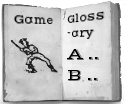Trap Ball
| Game | Trap Ball |
|---|---|
| Game Family | Fungo |
| Location | |
| Regions | |
| Eras | Predecessor |
| Invented | No |
| Tags | |
| Description | Trap ball is one of the earliest known ball games. Its distinguishing characteristic is the use of a “trap,” a mechanical device that, when triggered by a batter, lofts the ball to a height at which it may be struck. Most forms of trap ball do not involve running or bases; to the modern eye, it is a fungo-type game. Trap ball commonly used foul territory to define balls that were in play, where the “play” involved the catching and tossing back of the ball toward the batter. Trap ball persists today in Kent, England, as a tavern game. Per wikipedia article on "knurr and spell": "Knurr and spell (also called northern spell, nipsy or trap ball) is an old English game, once popular as a pub game. The game originated in the moors of Yorkshire, in England, but then spread throughout the north of England. It can be traced back to the beginning of the 14th century. It was especially popular in the 18th and 19th centuries, but was virtually unknown by the 21st century, though there was a local revival in the 1970s. As late as the 1930s exhibition games of knur and spell by veterans drew large crowds to the Rusland Valley in North Lancashire, according to the chronicles of the North-West Evening Mail, but even then it was regarded as an archaic game.... In Yorkshire it is played with a levered wooden trap known as a spell, by means of which the knurr, about the size of a walnut, is thrown into the air. In Lancashire the knurr is suspended stationary from string. The knurr is struck by the player with the stick. The object of the game is to hit the knurr the greatest possible distance, either in one or several hits. Each player competes as an individual, without interference, and any number can enter a competition. The stick is a bat consisting of two parts: a 4 feet (1.2 m) long stick made of ash or lancewood; and a pommel, a piece of very hard wood about 6 inches (150 mm) long, 4 inches (100 mm) wide and 1 inch (25 mm) thick. This was swung in both hands, although shorter bats for one hand were sometimes used. A successful hit drives the ball about 200 yards (180 m). The stroke is made by a full swing round the head, not unlike a drive in golf. Originally the ball was thrown into the air by striking a lever upon which it rested in the spell or trap, but in the later development of the game a spell or trap furnished with a spring was introduced, thus ensuring regularity in the height to which the knurr is tossed, somewhat after the manner of the shooter's clay pigeon. By means of a thumb screw, the player can adjust the spring of the spell or trap according to the velocity of release desired for the ball. On a large moor, and where the game is general, the ground is marked out with wooden pins driven in every 20 yards (18 m). In matches each player supplies their own knurrs and spells and has five rises of the ball to a game." In the US, in 1821 the Kensington House, a popular resort near NYC, advertised that its grounds were "well adapted to the playing of the noble game of cricket, base, trap-ball, quoits, and other amusements..." Illustration in Hone. |
| Sources | Wikipedia New York Evening Post, June 8, 1821 Aspin, "Ancient Customs, Sports, and Pastimes of the English" (1832) p. 223. Walker, "Games and Sports" (1837) p. 237. Hone, "The Spots and Pastimes of the People of England..." pp. 107-109 |
| Source Image | [[Image:|left|thumb]] |
| Comment | Edit with form to add a comment |
| Query | Edit with form to add a query |
| Has Supplemental Text |
Comments
<comments voting="Plus" />
